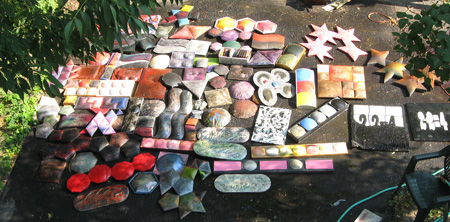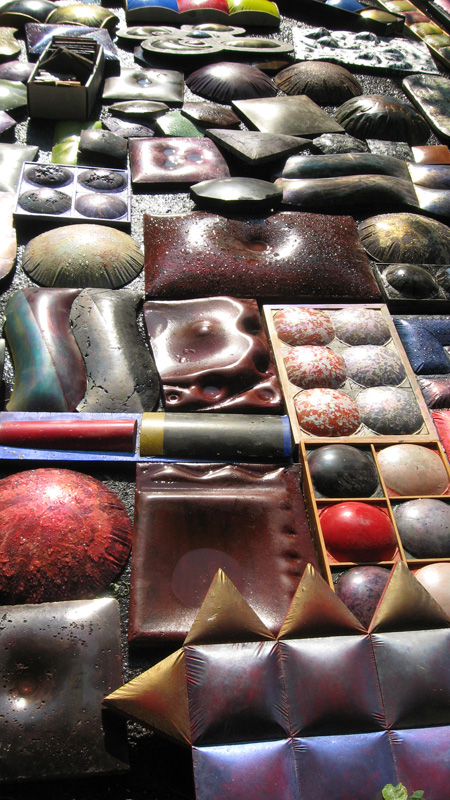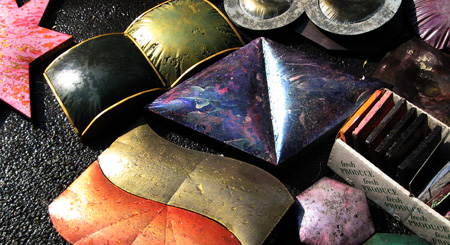I have been placed under oath to endeavor a cleansing of my own Augean Stables. There’s a lot of stuff around that could cause my heirs a world of headaches if left for them to handle.
To that end I have been rooting things out of their various hiding holes and exposing them to the light of day, thereupon to pass judgment. One category of item is cast plaster of which this is a gathering.


It all started when I poured plaster into a smooth depression of saran wrap covering a cooling bowl. I was so seduced by the result that I fell headlong into a trap of creating answers without questions. The plaster took colors so well and shined up so nicely that I followed the effects without regard for a coherent rationale.
I fell in love with the idea of manufacturing, of creating a big blooming mass of something. But, in the end, the plaster proved to be too heavy and fragile. If I want to do more of this kind of thing I will resort to expanded pvc which can replicate much of this and a lot more.

But, yes, I did learn a great deal from this experience, which I tend now to consider a kind of classwork in the school of hard knocks. My glitz fixation is ever so evident and it is clear that, in almost every instance I could have benefited from a greater complexity in the work. I had to learn beginner’s things – for example if one item is good , repeating it four times is not necessarily better. Or maybe I needed to repeat it a hundred times.
So I will have some people over to pick through and take what they want. I know, too, that some things will re-introduce themselves to me and suggest further development. But mostly, this is sort of a group photo of the condemned.
Is this what you have in mind June?

Jay —
The “trap of creating answers without questions” is a fine phrase — now all you have to do is find the question. In all seriousness, I think that that’s how most of us start — the answer first, then the question. Once we find the question, we move on with what we started somewhat vacantly. Sometimes it helps to have others see the work to give hints about direction or questions.
I can see the seduction in the cast plaster with your delights of color and texture. They seem to me to be sexy and tactile.
The first photo dummies them down, makes them lifeless, but the close-up of the next two photos resonate with me.
Someone said that landscape “didn’t need to be explained.” I’m wondering if that’s what is missing in your wanderings through shapes and textures — an explanation. Sometimes any old explanation will do. As someone said about one or another of the early 20th century modernists: “they did talk nonsense about their paintings, but what glorious work resulted from the nonsense.”
So I think, yes, this is what I had in mind. A further question that I would ask is how one pushes through the stopping place that you seem to have come to — what are the tricks? For me, it’s “meaning”, however nonsensical.
June:
Reminds me of the old song:”Explain yourself, it’s later than you think…”
I plan to push through the stopping place by the process of unburdening myself. My little results can act like so many post it notes attached to my psyche, or to be more dire, like scar tissue. Best bet is to lose the work but keep its lessons. For example, when not using a template derived from a design program, I was using the rim of something. Blunt circular and polygonal forms with no projections allowed for the greatest shape integrity but reduced free play. Thermally deformable plastics seem to allow me most of what I had with robust durability thrown in. Actually I have moved on in the sense that my scroll saw shapes are a partial outgrowth of this experience. And, furthermore, my big roll of saran wrap awaits if I can but solve the strength to weight issues.
Meaning? I believe that I have said this before, but I agree with those who see this existence suffused with another or others. Theorists talk about the possibility of we being part of a three-dimensional “membrane” embedded in a multi-dimensional context. This postulate serves its own purposes, but points in the general direction of a world o metaphysical assertions that talk about a profound inter penetration. Personally, I think that what we call aesthetics is a manifestation of something like this. So, for me, if I can produce a product that appears “right” without the support of topical content, then I may be more aligned with that which doth suffuse. But I keep looking for that content as it makes things better.
Jay, at first I thought you were talking about the physical appearances of your work — “interpenetration” being particularly relevant in your chains. But it sounds to me like you are working off a metaphysical concept, harking back to some of the early 20th century artists (sorry, I’m blanking on names entirely).
I had some really dumb questions to put to you, but I erased them. I suspect I operate on a lower plane than you.
June:
Concerning the plane: I doubt it. And, please overcome your blanking as I really want to know more about these twentieth century artists.
Maybe I obsess over a metaphysical that has met a physical. I’m not given to speculating, except when it imposes itself upon me – and I’m lousy at it anyway. It’s mostly a matter of trying to express a complex of feelings that I encounter in the process of using my senses. The sublime that we’ve been discussing is part of it. Sometimes this complex of feelings comes when I am in passive mode, as might happen in a museum. At other times I am trying to will it, as is happening now between words, as I idly move my head around, lining up some trees through the window to see what looks best. I can’t come up with a single reason why this craning about has any meaning or functional support as such, but better and worse occur.
I’m trying to understand Rudolph Steiner better as he was wont to place the spiritual and the physical on an equal, and equally accessible footing. And he appears to have drawn strong links between the spiritual and the aesthetic, and done so in the context of personal experience. I need a Steiner For Dummies primer as the man seems to have been like the proverbial elephant, and I one of the blind. If any of you is conversant with this man, a quick rundown of Steiner’s thoughts in this regard and how he thought them would be most appreciated.
Jay,
I applaud your cleanup! I love to throw stuff away; destruction can be a thought-generating and altogether creative act.
I’ve come across Rudolph Steiner in a couple of contexts lately, and would also like to know more about his ideas. Have you a provocative piece we could chew on in a post?
Steve:
That’s what I’M looking for. Steiner was all over the place: education, farming, economic theory, architecture, blackboard art, sculpture, the flow of water, Goethe and six thousand separate lectures delivered to everyone on virtually every topic under the sun. I am now trying to plow through his autobiography and feel as though in mud. For such a man of results, he seems to express himself in a vague sort of way. He’s juggling the notion of abstract thought as a form of spiritualism, but wrapping it in a cloudy layer of wool. Examples, metaphors, instances please! I’ve got a book on order out at Borders that may help, but I haven’t gotten the phone call from them yet.
Rudolf Steinerism seems to resemble communism, a good idea ill used. I know of bright children who went to a school using his ideas and ended up totally lost.